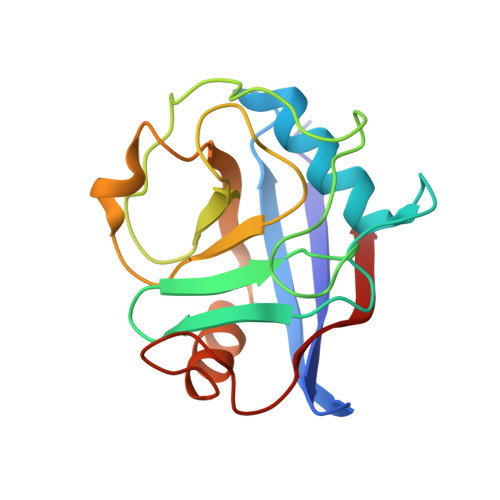Discovery of Potent Cyclophilin Inhibitors Based on the Structural Simplification of Sanglifehrin A.
Steadman, V.A., Pettit, S.B., Poullennec, K.G., Lazarides, L., Keats, A.J., Dean, D.K., Stanway, S.J., Austin, C.A., Sanvoisin, J.A., Watt, G.M., Fliri, H.G., Liclican, A.C., Jin, D., Wong, M.H., Leavitt, S.A., Lee, Y.J., Tian, Y., Frey, C.R., Appleby, T.C., Schmitz, U., Jansa, P., Mackman, R.L., Schultz, B.E.(2017) J Med Chem 60: 1000-1017
- PubMed: 28075591
- DOI: https://doi.org/10.1021/acs.jmedchem.6b01329
- Primary Citation of Related Structures:
5T9U, 5T9W, 5T9Z, 5TA2, 5TA4 - PubMed Abstract:
Cyclophilin inhibition has been a target for the treatment of hepatitis C and other diseases, but the generation of potent, drug-like molecules through chemical synthesis has been challenging. In this study, a set of macrocyclic cyclophilin inhibitors was synthesized based on the core structure of the natural product sanglifehrin A. Initial compound optimization identified the valine-m-tyrosine-piperazic acid tripeptide (Val-m-Tyr-Pip) in the sanglifehrin core, stereocenters at C14 and C15, and the hydroxyl group of the m-tyrosine (m-Tyr) residue as key contributors to compound potency. Replacing the C18-C21 diene unit of sanglifehrin with a styryl group led to potent compounds that displayed a novel binding mode in which the styrene moiety engaged in a π-stacking interaction with Arg55 of cyclophilin A (Cyp A), and the m-Tyr residue was displaced into solvent. This observation allowed further simplifications of the scaffold to generate new lead compounds in the search for orally bioavailable cyclophilin inhibitors.
Organizational Affiliation:
Selcia Ltd. , Fyfield Business & Research Park, Fyfield Road, Ongar, Essex CM5 0GS, United Kingdom.















